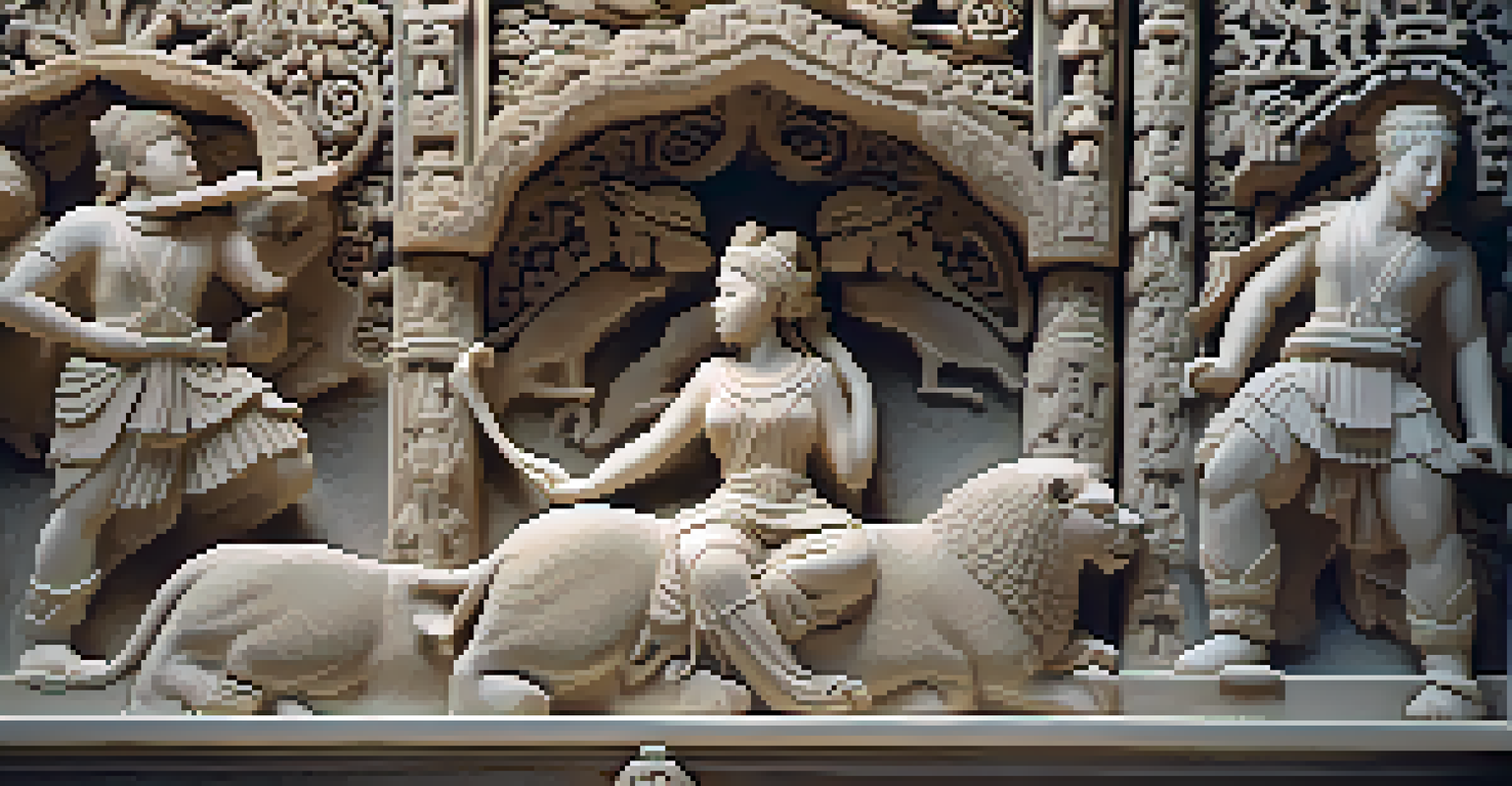Cultural Significance of Stone Carving Around the World

Introduction to Stone Carving as a Cultural Art Form
Stone carving is one of humanity’s oldest artistic practices, dating back thousands of years. It serves not just as a method of creating art but also as a means of storytelling and preserving culture. Each region's unique techniques and styles reflect the values, beliefs, and history of its people.
The stone is the most enduring of materials and the most difficult to carve, but the artist who persists finds beauty and meaning in the stone's depths.
From ancient Egyptian sculptures to modern abstract forms, stone carving encapsulates a wide range of expressions. This timeless medium allows artists to convey emotions and narratives that resonate across generations. The enduring nature of stone also symbolizes permanence in a world of change.
As we delve deeper into the significance of stone carving around the globe, it's essential to recognize how these creations connect communities. They often serve as focal points for cultural identity, bridging the past with the present and offering insight into the human experience.
Historical Significance of Stone Carving in Ancient Civilizations
In ancient civilizations, stone carving played a crucial role in religious and cultural practices. The Egyptians, for instance, used stone to create monumental sculptures that honored their gods and pharaohs, reinforcing their beliefs and societal structure. These carvings were not merely decorative but held deep spiritual significance.

Similarly, the Greeks and Romans utilized stone to convey ideals of beauty and power. Their intricate statues and architectural designs embodied their philosophical values and celebrated human achievement. Stone carving thus became a medium for conveying complex ideas and societal aspirations.
Cultural Significance of Stone Carving
Stone carving serves as a vital expression of cultural identity, preserving traditions and stories across generations.
These historical examples illustrate how stone carving served as a visual language that communicated values and beliefs across time. By understanding these ancient practices, we can appreciate the broader cultural narratives that stone carvings represent today.
The Role of Stone Carving in Indigenous Cultures
Indigenous cultures around the world have long used stone carving to express their identity and heritage. For many, these carvings are not only artistic expressions but also vital elements of their cultural traditions. They often depict ancestral stories, spiritual beliefs, and connections to the land.
Art is the most beautiful of all lies; stone carving is the most truthful of all arts.
For example, Native American tribes have a rich tradition of stone carving, using materials like soapstone to create intricate figures and totems. These carvings serve as a way to honor their ancestors and preserve their cultural narratives for future generations. Each piece is infused with meaning, reflecting the community's values and history.
By recognizing the significance of stone carving in indigenous cultures, we can better appreciate the deep connections between art, identity, and tradition. These works of art are not just beautiful; they are vital links to understanding and preserving cultural heritage.
Stone Carving Techniques and Their Cultural Implications
The techniques used in stone carving vary widely across different cultures, each reflecting unique traditions and skills. From the chisel and hammer methods of ancient Egypt to the sophisticated tools used in modern sculpture, these techniques have evolved but remain rooted in cultural practices. Each method carries its own history and significance.
In some cultures, the choice of stone is vital, as certain types are believed to hold spiritual or healing properties. For instance, in many Asian cultures, jade is highly valued not only for its beauty but also for its symbolism of purity and protection. Thus, the materials chosen for carving often enhance the piece's cultural meaning.
Historical Impact on Civilizations
Ancient civilizations used stone carving as a powerful medium to convey spiritual beliefs and societal values.
Understanding these techniques allows us to appreciate the artistry involved in stone carving. It highlights how culture shapes the creation process and the resulting artworks, making each piece a reflection of its origin and the people who crafted it.
Modern Interpretations of Stone Carving
In contemporary art, stone carving continues to evolve, merging traditional techniques with modern themes. Artists today often challenge the boundaries of stone as a medium, experimenting with form and concept. This fusion of old and new reflects the dynamic nature of cultural expression.
For instance, modern sculptors might incorporate abstract elements or mixed media into their stone works, creating pieces that resonate with current societal issues. This approach not only revitalizes the art form but also invites dialogue about contemporary life and its complexities.
By embracing innovation, contemporary stone carving honors its historical roots while remaining relevant in today’s art scene. It illustrates how cultural significance can adapt and transform, ensuring that the tradition of stone carving endures in new and exciting ways.
The Influence of Stone Carving on Architecture
Stone carving has profoundly influenced architectural design throughout history. From the grandeur of Gothic cathedrals adorned with intricate stone sculptures to the minimalist aesthetics of modern buildings, stone carving has shaped how we experience space. Architectural stonework often serves as a visual narrative, telling stories through its design.
In many cultures, the care and craftsmanship involved in stone carving reflect a deep reverence for the materials and the environment. Structures like the Taj Mahal and the Parthenon showcase the skill involved in melding functionality with artistry, creating spaces that inspire awe and reflection.
Modern Evolution and Preservation
Contemporary artists are merging traditional stone carving techniques with modern themes, ensuring the art form remains relevant today.
As we appreciate these architectural masterpieces, we recognize that stone carving is more than just a decorative element; it is a vital component of cultural and historical identity. The interplay between stone carving and architecture continues to influence how we build and perceive our environments.
Preserving the Legacy of Stone Carving for Future Generations
As we move forward in a rapidly changing world, preserving the tradition of stone carving becomes increasingly important. Many cultural practices, including stone carving, face challenges from modernization and globalization. Ensuring the continuation of these art forms requires both community effort and education.
Organizations and artists are working to document and teach traditional stone carving techniques, fostering a new generation of artisans. Workshops and cultural exchanges play a significant role in keeping these practices alive, ensuring that the skills and stories associated with stone carving are not lost.

By investing in the preservation of stone carving, we honor the rich cultural heritage it represents. This commitment not only celebrates the past but also enriches our present, allowing future generations to connect with their roots through this enduring art form.